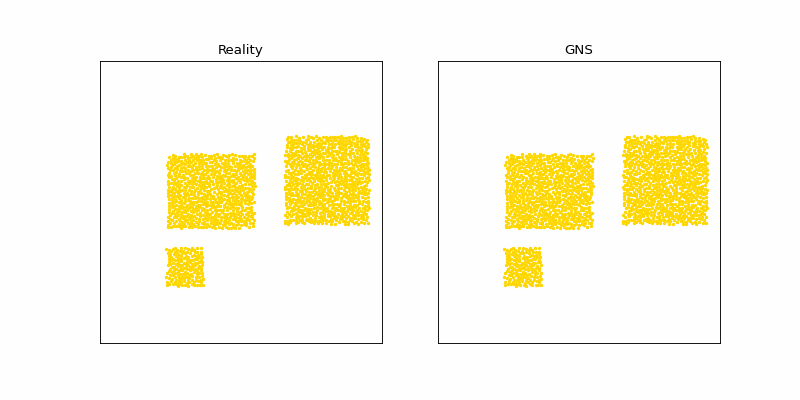Krishna Kumar, The University of Texas at Austin.
Joseph Vantassel, Texas Advanced Computing Center, UT Austin.
Graph Network-based Simulator (GNS) is a framework for developing generalizable, efficient, and accurate machine learning (ML)-based surrogate models for particulate and fluid systems using Graph Neural Networks (GNNs). GNS code is a viable surrogate for numerical methods such as Material Point Method, Smooth Particle Hydrodynamics and Computational Fluid dynamics. GNS exploits distributed data parallelism to achieve fast multi-GPU training. The GNS code can handle complex boundary conditions and multi-material interactions.
Training
python3 -m gns.train --data_path="<input-training-data-path>" --model_path="<path-to-load-save-model-file>" --output_path="<path-to-save-output>" -ntraining_steps=100Resume training
To resume training specify model_file and train_state_file:
python3 -m gns.train --data_path="<input-training-data-path>" --model_path="<path-to-load-save-model-file>" --output_path="<path-to-save-output>" --model_file="model.pt" --train_state_file="train_state.pt" -ntraining_steps=100Rollout
python3 -m gns.train --mode="rollout" --data_path="<input-data-path>" --model_path="<path-to-load-save-model-file>" --output_path="<path-to-save-output>" --model_file="model.pt" --train_state_file="train_state.pt"Render
python3 -m gns.render_rollout --output_mode="gif" --rollout_dir="<path-containing-rollout-file>" --rollout_name="rollout_0"The renderer also writes .vtu files to visualize in ParaView.
GNS prediction of Sand rollout after training for 2 million steps.
The data loader provided with this PyTorch implementation utilizes the more general .npz format. The .npz format includes a list of
tuples of arbitrary length where each tuple is for a different training trajectory
and is of the form (position, particle_type). position is a 3-D tensor of
shape (n_time_steps, n_particles, n_dimensions) and particle_type is
a 1-D tensor of shape (n_particles).
The dataset contains:
-
Metadata file with dataset information (sequence length, dimensionality, box bounds, default connectivity radius, statistics for normalization, ...):
-
npz containing data for all trajectories (particle types, positions, global context, ...):
We provide the following datasets:
WaterDropSample(smallest dataset)SandSandRamps
Download the dataset from DesignSafe DataDepot. If you are using this dataset please cite Vantassel and Kumar., 2022
- to setup a virtualenv
sh ./build_venv.sh- check tests run sucessfully.
- start your environment
source start_venv.sh PyTorch version of Graph Network Simulator based on https://arxiv.org/abs/2002.09405 and https://github.com/deepmind/deepmind-research/tree/master/learning_to_simulate.
This code is based upon work supported by the National Science Foundation under Grant OAC-2103937.
Kumar, K., & Vantassel, J. (2022). Graph Network Simulator: v1.0.1 (Version v1.0.1) [Computer software]. https://doi.org/10.5281/zenodo.6658322
Vantassel, Joseph; Kumar, Krishna (2022) “Graph Network Simulator Datasets.” DesignSafe-CI. https://doi.org/10.17603/ds2-0phb-dg64 v1


